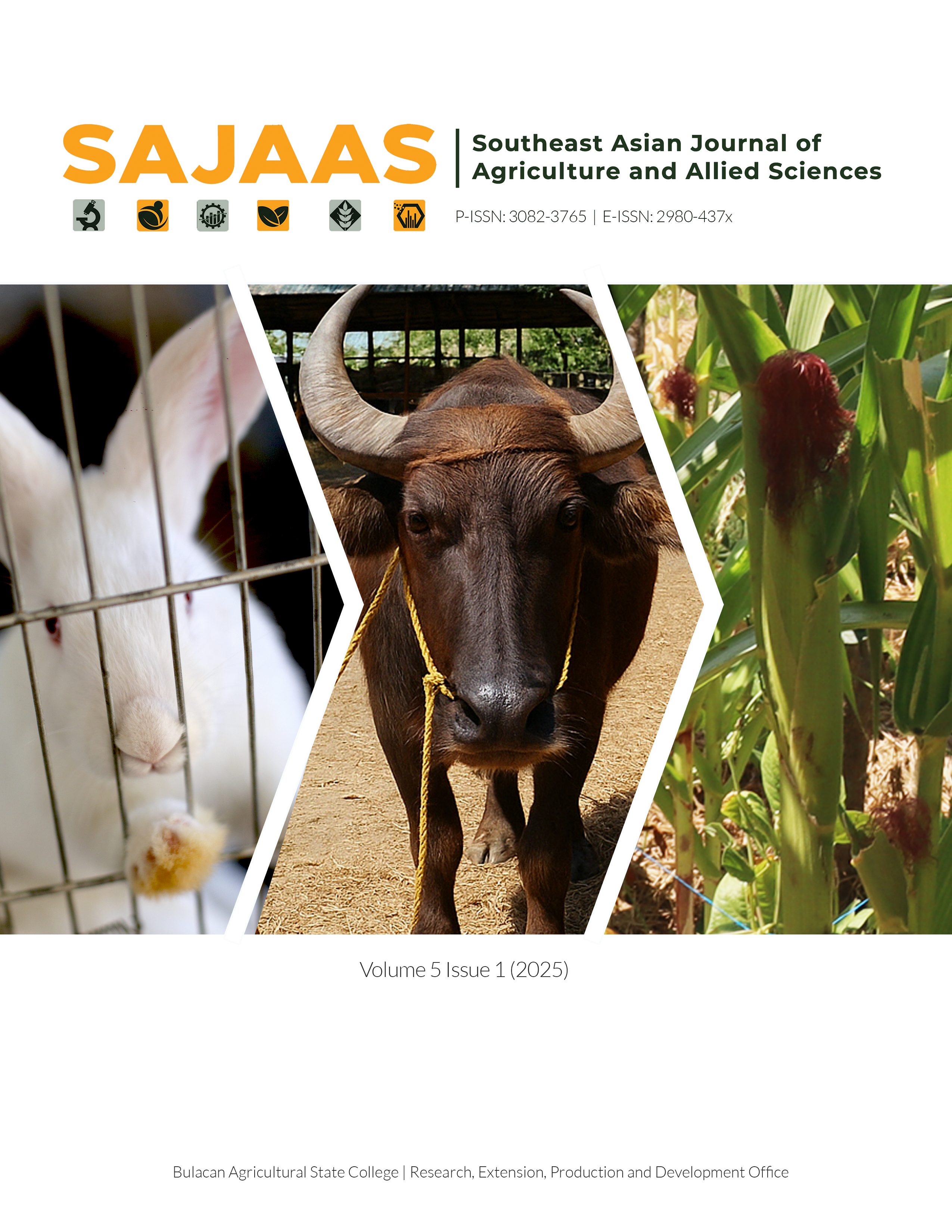Abstract
The study was conducted to determine the growth performance and carcass traits of Cobb® Broiler broilers supplemented with different preparations of butterfly pea (Clitoria ternatea) at varying inclusion frequencies. The study used the 3x2 factorial in Completely Randomized Design, with the type of butterfly pea preparation as factor A (A1 – Control Group, A2 – butterfly pea flower (BPF) as fermented juice, and A3 – BPF decoction, both supplemented in drinking water (10%), whereas factor B was the frequency of supplementation (B1 – every day, B2 – every other day). Day-old Cobb broiler chicks with similar average weight of 50–60 grams were randomly distributed to six groups, which had three replicates each, and seven birds per replicate, for a total of 126 birds. The body weight, average weight gain, and feed conversion ratio revealed there was no interaction effect for the two factors, but there were highly significant differences among the control and BPF preparations, and between the two frequencies of supplementation. Butterfly pea flower-treated groups had better results than the control, with BPF-fermented juice (A2) having the best results, followed by BPF-decoction (A3). Between the frequencies, it was everyday supplementation (B1) that showed better performance values. No significant differences were observed on carcass traits including dressed weight, carcass percentage, and relative organ weights (liver, spleen, gizzard, and heart).
References
Afrianto, W. F., Tamnge, F., & Nur Hasanah, L. (2020). A relation between ethnobotany and bioprospecting of edible flower Butterfly pea (Clitoria ternatea) in Indonesia. Asian Journal of Ethnobiology, 3(2), 51–61. https://doi.org/10.13057/asianjethnobiol/y030202
Fairchild, B. (2012). Environmental factors to control when brooding chicks (University of Georgia Cooperative Extension Bulletin 1287). University of Georgia. https://extension.uga.edu/publications/detail.html?number=B1287&title=environmental-factors-to-control-when-brooding-chicks
Gomez, S. M., & Kalamani, A. (2003). Butterfly pea (Clitoria ternatea): A nutritive multipurpose forage legume for the tropics - An overview. Pakistan Journal of Nutrition, 2(6), 374–379. https://doi.org/10.3923/pjn.2003.374.379
Haniarti, Munir, Akib, M. A., Ambar, A., Rusman, A. D. P., & Abdullah, A. (2018). Herbal for increasing immunity and weight of poultry. IOP Conference Series: Earth and Environmental Science, 247(1), 012056. https://doi.org/10.1088/1755-1315/247/1/012056
Huervana, J. F. (2016). Influence of fermented organic concoction as nutrient supplements in the performance of brooding native chicken. WVSU Research Journal, 5(2), 35–44.
Manuel, J. A. (2015). Growth and performance of broiler chickens supplemented with Moringa oleifera tea. NVSU Research Journal, 2(1), 34–39. https://www.nvsu.edu.ph/assets/downloads/journal/vol2-1/NVSURJ_Vol.2_01_2015_4.pdf
Muhammad Ezzudin, R., & Rabeta, M. S. (2018). A potential of telang tree (Clitoria ternatea) in human health. Food Research, 2(5), 415–420. https://doi.org/10.26656/fr.2017.2(5).073
Nicolas, H. J. (2017). Performance and carcass traits of broiler chickens fed diets supplemented with aged garlic extract or humates with probiotics at different growth stages. Philippine Journal of Veterinary and Animal Sciences, 43(2), 109–115. https://www.pjvas.org/index.php/pjvas/article/view/172
Philippine Statistics Authority. (2025). Chicken situation report: January–December 2024 (ISSN 2546-0625). https://library.psa.gov.ph/cgi-bin/koha/opac-retrieve-file.pl?id=811c23970303aeaedfe8610e6386eed3
Plaza, L. P. (2017). Performance, gross morphology, histopathology and morphometry of the gut of broilers as influenced by chitosan derivatives and Saccharomyces cerevisiae boulardii at different inclusion frequencies. Philippine Journal of Arts, Science, and Technology, 2(1), 15–21. http://tau.edu.ph:8085/index.php/pjast/article/view/16
Putri, T. F., Wasita, B., & Indarto, D. (2023). Administrations of butterfly pea flower (Clitoria ternatea L.) extract reduce oxidative stress and increase body weight of male Wistar rats with diabetes. Amerta Nutrition, 7(3), 400–405. https://doi.org/10.20473/amnt.v7i3.2023.400-405
Ravindran, V., & Abdollahi, M. R. (2021). Nutrition and digestive physiology of the broiler chick: State of the art and outlook. Animals (Basel), 11(10), 2795. https://doi.org/10.3390/ani11102795
Sapsuha, Y., Sjafani, N., Fatmona, S., & Tjokrodiningrat, S. (2023). Butterfly pea (Clitoria ternatea) extract as a potential feed additive for broiler chickens. Livestock Research for Rural Development, 35, Article 89. http://www.lrrd.org/lrrd35/10/3589yus.html
Vidana Gamage, G. C., Lim, Y. Y., & Choo, W. S. (2021). Anthocyanins from Clitoria ternatea flower: Biosynthesis, extraction, stability, antioxidant activity, and applications. Frontiers in Plant Science, 12, Article 792303. https://doi.org/10.3389/fpls.2021.792303
Yassin, H., Velthuis, A. G. J., Boerjan, M., & van Riel, M. (2009). Field study on broiler first week mortality. Poultry Science, 88(4), 798–804. https://doi.org/10.3382/ps.2008-00292

This work is licensed under a Creative Commons Attribution-NonCommercial-ShareAlike 4.0 International License.
Copyright (c) 2025 Southeast Asian Journal of Agriculture and Allied Sciences

